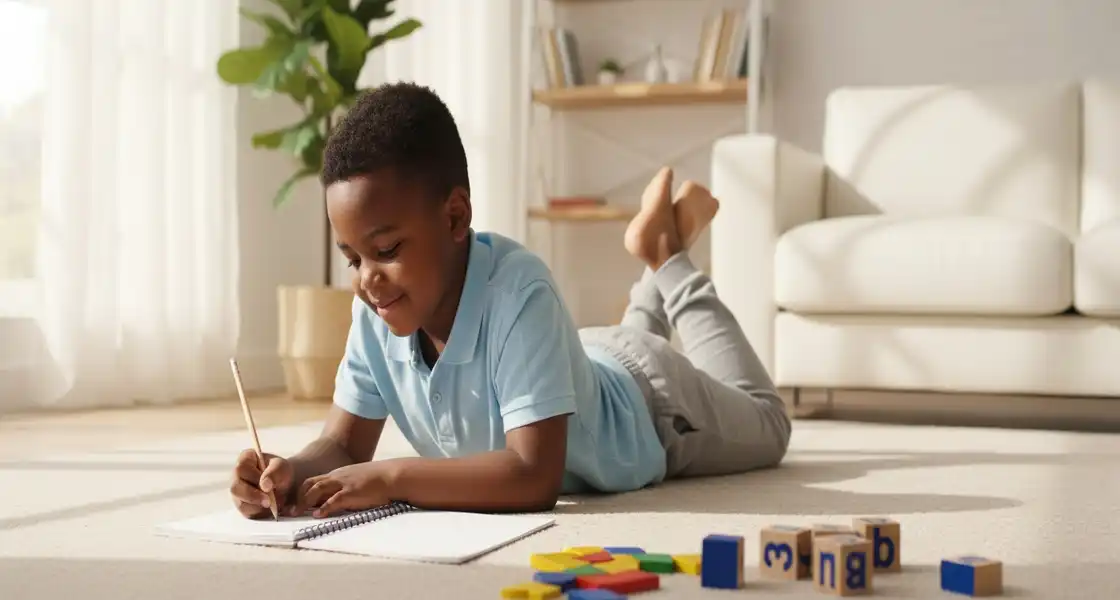When your eight-year-old races through "The cat sat on the mat" but slows down on "The boat sailed in the rain," you’re seeing a completely normal step in their reading journey. Those trickier words use vowel teams: two vowels working together to make one sound. With 25 recognized vowel teams in English, it’s no wonder kids sometimes get frustrated.
Once your child begins to see how these teams work, an entire world of new words opens up, bringing more smiles, confidence, and joy into their reading time. Outschool offers live online phonics classes that give your child personalized support. Experienced teachers make tricky vowel teams simple and fun. With flexible options, your learner can build confidence right from home.
Why vowel teams matter for early reading and spelling development
Understanding vowel teams early gives your child a strong foundation in both reading and spelling. These combinations show up in everyday words, and once kids can spot and use them, reading feels less like guessing and more like discovery. Here are a few key reasons vowel teams are so important:
- They appear often in common and multisyllabic words, helping kids tackle longer vocabulary with confidence.
- They strengthen both decoding (reading) and encoding (spelling) skills at the same time.
- They provide reliable patterns that make English spelling less confusing.
- They serve as a bridge from simple three-letter words to chapter books and advanced texts.
- They boost confidence and independence, turning reading into an enjoyable experience.
What are vowel teams?
Vowel teams are simply pairs of vowels that come together to make a single sound, like the “ai” in rain or the “oa” in boat. Think of them as friendly partnerships between letters, working together to give kids reliable patterns for reading and spelling. When your child starts noticing these patterns, tricky words feel less intimidating, and every new word becomes a chance to build confidence, independence, and joy in reading.
25 Standard vowel teams
These 25 vowel teams appear across everyday English words, making them valuable learning patterns for children. Parents don’t need to introduce all of them at once. You can start with the most common ones to make it more manageable.
Vowel team
Common sound(s)
Examples
Notes
ai
Long A
rain, train, paint
Easy to practice during weather or art activities
ea
Long E / Short E
beach, teacher / bread, head
Teach long E first, then introduce short E variations
ee
Long E
tree, free, three
One of the most reliable patterns to start with
oa
Long O
boat, coat, soap
Everyday words make this pattern simple to spot
ou
/ow/ and Long O
house, mouse / soul
A trickier team that may take extra practice to master
oo
Long OO / Short OO
moon, food / book, look
Can be confusing since it makes two different sounds
au
/aw/
author, autumn, sauce
Often found in academic and seasonal words
aw
/aw/
saw, paw, draw
Common in everyday language
oi
/oy/
coin, join, boil
Fun to spot in rhyming games
oy
/oy/
boy, toy, enjoy
Easy to learn with playful words
ow
/ow/ and Long O
cow, now / snow, grow
Kids should learn both sounds with context
ew
Long U / OO
new, few / stew, chew
Teaches flexibility in sound patterns
ui
Long U
fruit, suit, juice
A less common team, but important for everyday words
ue
Long U
blue, clue, true
Easy to reinforce with color words
ey
Long E / Long A
key, monkey / they, grey
Two sounds, teach one at a time
ei
Long A / Long E
vein, reins / ceiling, receive
Less common, but shows up in tricky spelling patterns
ie
Long E / Long I
field, chief / pie, tie
Introduce Long E before Long I
igh
Long I
high, night, light
A three-letter team to practice
eigh
Long A
eight, weight, neighbor
A tricky but important pattern
oe
Long O
toe, foe, goes
Easy to pair with 'oa' for comparison
eu
/yoo/
Europe, neutral
Rare but valuable for advanced readers
ir
/er/
bird, shirt
Part of r-controlled vowels, worth noting
ur
/er/
fur, turn
Another r-controlled vowel team
er
/er/
her, fern
Common and simple to practice
or
/or/
for, corn
Very frequent in beginner texts
ar
/ar/
car, star
Kids enjoy finding these in simple stories
How parents can teach vowel teams at home
Helping your child learn vowel teams doesn’t have to be complicated. With a little creativity and encouragement, you can turn everyday moments into fun reading practice. Here are some simple ways to get started:
1. Create playful learning moments
Try word hunts around the house where kids look for items containing vowel teams, or play games like bingo and matching cards. Reading aloud together also naturally highlights these sounds in stories.
2. Connect learning to real life
On family outings, encourage your child to be a vowel team detective by spotting patterns on signs, menus, or displays. Cooking is another great time to notice vowel teams in recipes, and even community projects offer opportunities to read words containing these patterns.
3. Celebrate small victories
Since vowel teams can be tricky, be patient and encourage your child. Celebrate attempts, talk about mistakes as learning steps, and keep the tone light and positive. This builds resilience, curiosity, and long-term confidence in reading.
4. Seek support and community
Every child learns differently. Connecting with other families and educators can help you find new strategies and encouragement as you guide your child through these reading milestones.
Frequently asked questions (FAQs) about vowel teams
These vowel teams FAQ responses address the most common concerns in homeschooling communities, and you're not alone in wondering about the best approaches for your child.
What are some tips for helping a child who mixes up vowel team sounds?
Start by focusing on one vowel team at a time rather than introducing multiple teams simultaneously, as 25 standard vowel teams in English can easily overwhelm young learners. Create visual anchors by pairing each vowel team with a memorable word and picture, like "rain" for 'ai' or "boat" for 'oa', and practice these consistently before moving to new patterns. Mixing up sounds is completely normal. Gentle repetition and patience will help your child build confidence over time.
How can I tell if my child is ready to learn vowel teams?
Your child is usually ready for vowel teams when they can confidently identify individual letter sounds and blend simple consonant-vowel-consonant words like "cat" or "dog." They should also show comfort with short vowel sounds. Additionally, they should be able to read basic sight words before tackling the more complex patterns that vowel teams represent. If your child is around 6-7 years old and showing curiosity about longer words, they're likely ready to begin this next step in their reading journey.
Are there exceptions or tricky vowel teams I should know about?
Yes, some vowel teams can be particularly challenging because they make different sounds in different words. The 'ea' team is a perfect example, making one sound in "bread" and another in "beach." The old saying "when two vowels go walking, the first one does the talking" doesn't always apply, so it's better to teach vowel teams as patterns with their unique sounds rather than relying on this rule.
How can I support neurodiverse learners or children who struggle with phonics when teaching vowel teams?
Break vowel teams into even smaller steps, perhaps spending extra time on just 2-3 teams before introducing others, and use multi-sensory approaches like tracing letters in sand or using colored markers to highlight patterns. Many children benefit from kinesthetic learning, so incorporate movement to help reinforce the connections between sounds and letters. Remember that every child learns at their own pace, and celebrating small victories builds the confidence needed for long-term success.
Give your child confidence with vowel teams
Teaching vowel teams doesn’t have to feel hard. It can be a fun and natural part of your child’s reading journey. Simple games, everyday examples, and encouragement can turn tricky words into exciting wins. Every child learns in their own way, and cheering for small steps builds steady confidence.
Outschool makes it easier with flexible live online classes for reading and phonics, including small-group sessions focused on vowel teams and decoding. The right class can spark confidence, make reading enjoyable, and open the door to a lifetime of learning.


.svg)
.svg)


.webp)




